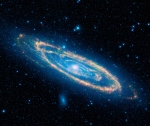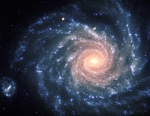From http://www.jpl.nasa.gov/gallery/
 The immense Andromeda galaxy, also known as Messier 31 or simply M31, is captured in full in this new image from NASA’s Wide-field Infrared Survey Explorer, or WISE. The mosaic covers an area equivalent to more than 100 full moons, or five degrees across the sky. WISE used all four of its infrared detectors to capture this picture (3.4- and 4.6-micron light is colored blue; 12-micron light is green; and 22-micron light is red). Blue highlights mature stars, while yellow and red show dust heated by newborn, massive stars.
The immense Andromeda galaxy, also known as Messier 31 or simply M31, is captured in full in this new image from NASA’s Wide-field Infrared Survey Explorer, or WISE. The mosaic covers an area equivalent to more than 100 full moons, or five degrees across the sky. WISE used all four of its infrared detectors to capture this picture (3.4- and 4.6-micron light is colored blue; 12-micron light is green; and 22-micron light is red). Blue highlights mature stars, while yellow and red show dust heated by newborn, massive stars.
Andromeda is the closest large galaxy to our Milky Way galaxy, and is located 2.5 million light-years from our sun. It is close enough for telescopes to spy the details of its ringed arms of new stars and hazy blue backbone of older stars. Also seen in the mosaic are two satellite galaxies, known as M32, located just a bit above Andromeda to the left of center, and the fuzzy blue M110, located below the center of the great spiral arms. These satellites are the largest of several that are gravitationally bound to Andromeda.
The Andromeda galaxy is larger than our Milky Way and contains more stars, but the Milky Way is thought to perhaps have more mass due to its larger proportion of a mysterious substance called dark matter. Both galaxies belong to our so-called Local Group, a collection of more than 50 galaxies, most of which are tiny dwarf systems. In its quest to map the whole sky, WISE will capture the entire Local Group.
 This infrared image taken by NASA’s Wide-field Infrared Survey Explorer, or WISE, shows a star-forming cloud teeming with gas, dust and massive newborn stars. The inset reveals the very center of the cloud, a cluster of stars called NGC 3603. It was taken in visible light by NASA’s Hubble Space Telescope.
This infrared image taken by NASA’s Wide-field Infrared Survey Explorer, or WISE, shows a star-forming cloud teeming with gas, dust and massive newborn stars. The inset reveals the very center of the cloud, a cluster of stars called NGC 3603. It was taken in visible light by NASA’s Hubble Space Telescope.
WISE, which is surveying the whole sky in infrared light, is particularly sensitive to the warm dust that permeates star-forming clouds like this one. In this way, WISE complements visible-light observations.
The mission also complements Hubble and other telescopes by showing the ‘big picture,” providing context for more detailed observations. For example, the WISE picture here is 2,500 times larger than the Hubble inset. While the Hubble view shows the details of the hot young star cluster, the WISE picture shows the effects that this stellar powerhouse has on its neighborhood.
The cluster contains some of the most massive stars known. Winds and radiation from the stars are evaporating and dispersing the cloud material from which they formed, warming the cold dust and gas surrounding the central nebula. This greenish “halo” of warm cloud material is seen best by WISE due to its large field of view and improved sensitivity over past all-sky infrared surveys.
These WISE observations provide circumstantial evidence that the massive stars in the center of the cluster triggered the formation of younger stars in the halo, which can be seen as red dots. The dust at the center of the cluster is very hot, producing copious amounts of infrared light, which results in the bright, yellow cores of the nebulosity.
Ultimately, this turbulent region will be blasted apart by supernova explosions. Other star-forming clouds in the Milky Way have experienced such eruptions, as evidenced by their pockmarked clouds of expanding cavities and bubbles.
Massive star clusters like this one are an important link to understanding the details of the violent original epoch of massive star formation in the early, distant universe. Astronomers also use them to study distant starbursts that occur when galaxies collide, lighting up tremendous firestorms of brilliant, but ephemeral, stars in the wreckage. Because NGC 3603 is so close, it is an excellent lab for the study of such faraway and momentous events.
NASA’s Jet Propulsion Laboratory, Pasadena, Calif., manages the Wide-field Infrared Survey Explorer for NASA’s Science Mission Directorate, Washington. The mission’s principal investigator, Edward Wright, is at UCLA. Caltech manages JPL for NASA.
More information is online at http://www.nasa.gov/wise and http://wise.astro.ucla.edu.
Image Credit: NASA/JPL-Caltech/UCLA
Image Addition Date: 2010-02-17
 The more I think about heaven, the more I think about space. Stars, solar systems, galaxies, nebulas, pulsars, quasars, black holes, all I find really fascinating.
The more I think about heaven, the more I think about space. Stars, solar systems, galaxies, nebulas, pulsars, quasars, black holes, all I find really fascinating.

